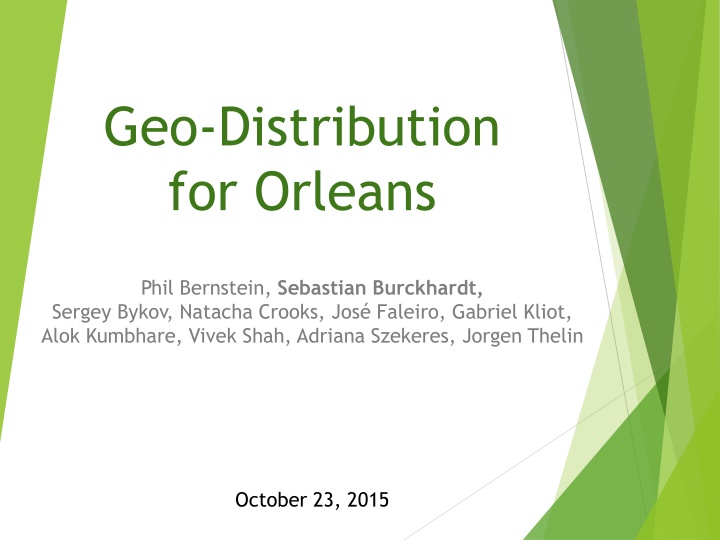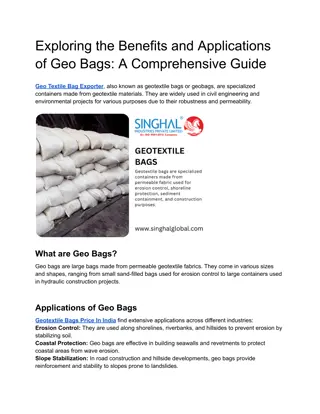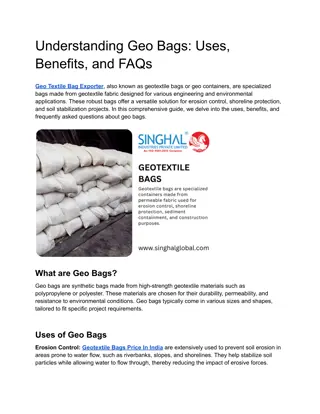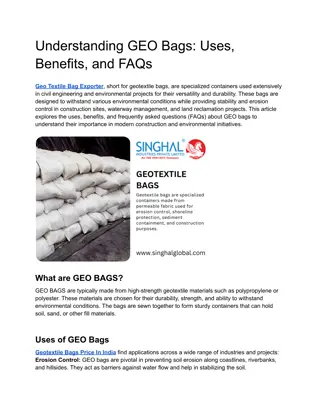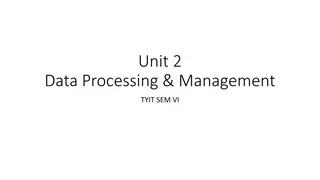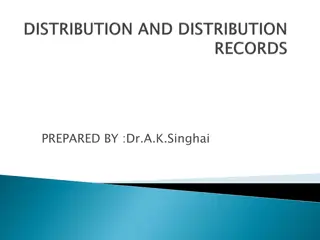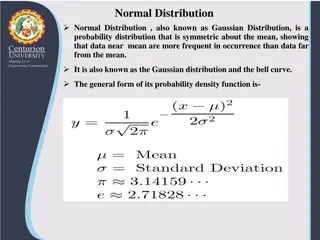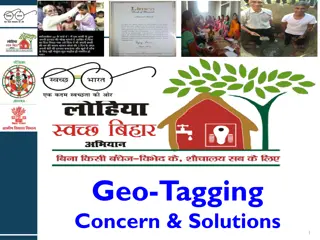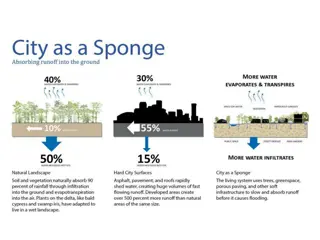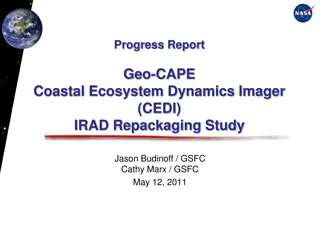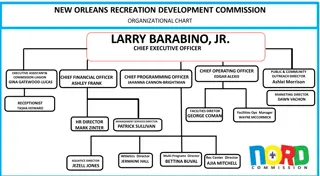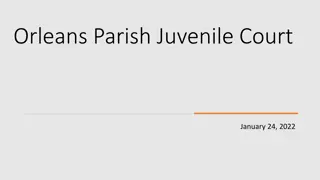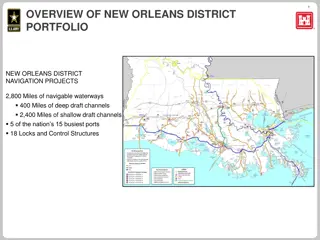Geo-Distribution for Orleans
Explore the geo-distribution strategy for Orleans through discussing meeting goals, design challenges, and proposed components like Multi-Cluster Configuration, Queued Grains, Global Single-Instance Grains, and Replication Providers. Understand the reasons for geo-distribution, design challenges, component dependencies, and the configuration process in different network environments such as Azure. Connect with early adopters and gather feedback on user requirements and design ideas.
Download Presentation

Please find below an Image/Link to download the presentation.
The content on the website is provided AS IS for your information and personal use only. It may not be sold, licensed, or shared on other websites without obtaining consent from the author.If you encounter any issues during the download, it is possible that the publisher has removed the file from their server.
You are allowed to download the files provided on this website for personal or commercial use, subject to the condition that they are used lawfully. All files are the property of their respective owners.
The content on the website is provided AS IS for your information and personal use only. It may not be sold, licensed, or shared on other websites without obtaining consent from the author.
E N D
Presentation Transcript
Geo-Distribution for Orleans Phil Bernstein, Sebastian Burckhardt, Sergey Bykov, Natacha Crooks, Jos Faleiro, Gabriel Kliot, Alok Kumbhare, Vivek Shah, Adriana Szekeres, Jorgen Thelin October 23, 2015
Goals for the meeting Explain the four main components of the proposed architecture Multi-Cluster Configuration Queued Grains Global Single-Instance Grains Replication Providers Solicit feedback on user requirements and design ideas Connect with early adopters
Why Geo-Distribution? Better Service Latency use datacenter close to client for servicing that client Better Fault Tolerance application is available despite datacenter failure 3
Design Challenges / Proposed Components Administration and Configuration How to connect multiple clusters? How to add/remove clusters on-the-fly? Multi-Cluster Configuration Choose & Implement a Programming Model (default) Independent grain directories? Global Single-Instance Grains One grain instance globally? Multiple grain copies that synchronize? Queued Grains Replication Providers 4
Talk Outline & Component Dependencies 1 3 Multi-Cluster Configuration Queued Grains 4 2 Global Single-Instance Grains Replication Providers 5
Part 1: Multi-Cluster Configuration 6
Multi-Cluster Configuration Multi-Cluster C A B Orleans manages each cluster as usual But now, there can be more than one such cluster. 7
Multi-Cluster Configuration Physical Network C A B We assume that all nodes can connect via TCP This may require some networking configuration (outside scope of Orleans) 8
Multi-Cluster Configuration Azure Multi-Cluster Example Europe (Production) Europe (Staging) US-West VNET C B A VNET VNET GATEWAY Storage Storage 9
Multi-Cluster Configuration Discovery, Routing, Administration ? B A C Channel 1 Channel 2 To share routing and configuration information, connect clusters by two or more gossip channels No single point of failure Currently, each gossip channel is an Azure table 10
Multi-Cluster Configuration Example: Configuration On Cluster A: <MultiClusterNetwork GlobalServiceId="MyService" ClusterId="A"> <GossipChannel Type="AzureTable" ConnectionString= Channel_1" /> <GossipChannel Type="AzureTable" ConnectionString= Channel_2" /> </MultiClusterNetwork> On Cluster B: <MultiClusterNetwork GlobalServiceId="MyService" ClusterId= B"> <GossipChannel Type="AzureTable" ConnectionString= Channel_1" /> <GossipChannel Type="AzureTable" ConnectionString= Channel_2" /> </MultiClusterNetwork> On Cluster C: 11 <MultiClusterNetwork GlobalServiceId="MyService" ClusterId= C"> <GossipChannel Type="AzureTable" ConnectionString= Channel_1" /> <GossipChannel Type="AzureTable" ConnectionString= Channel_2" /> </MultiClusterNetwork>
Multi-Cluster Configuration Connected Joined Connecting to the multi-cluster network does not mean a cluster is part of the active configuration yet. Active configuration is controlled by administrator carries a timestamp and a comment never changes on its own (i.e. is completely independent of what nodes are connected, working, or down)
Multi-Cluster Configuration Changing active configuration Administrator injects timestamped configuration on any cluster Automatically spreads through gossip channels var systemManagement = GrainClient.GrainFactory.GetGrain<IManagementGrain>( RuntimeInterfaceConstants.SYSTEM_MANAGEMENT_ID); systemManagement.InjectMultiClusterConfiguration( new Orleans.MultiCluster.MultiClusterConfiguration( DateTime.UtcNow, "A,B,C", "I am now adding cluster C" )); 13
Part 2: Global Single-Instance Grains 14
Global Single-Instance Grains [GlobalSingleInstance] public class MyGrain : Orleans.Grain, IMyGrain { ... } Grains marked as single-instance are kept in a separate directory that is coordinated globally Calls to the grain are routed to the cluster containing the current activation (if it exists) a new activation in the caller s cluster (otherwise) 15
Global Single-Instance Grains Typical indications for using a global-single-instance grain The vast majority of accesses to the grain are in one cluster. But the grain needs to be instantiable in different clusters at different times, e.g., due to: Changing access patterns Cluster failure 16
Global Single-Instance Grains Example: A Game Grain Single-Instance Game Grain Silo Silo Silo Silo Silo Silo Frontend Frontend DC1 DC2 Clients Clients 17
Global Single-Instance Grains Example: A Game Grain New Single- Instance Game Grain Silo Silo Silo Silo Silo Silo Frontend Frontend DC1 DC2 Clients Clients 18
Global Single-Instance Grains Guarantees If cross-cluster communication is functional, at most one activation globally. If cross-cluster communication is broken, there may be multiple activations temporarily Duplicate instances are automatically deactivated once communication is restored Same as for regular single-cluster grains today! 19
Part 3: Queued Grains 20
Queued Grains Concerning Performance... Global coordination is relatively slow and not always needed. often o.k. to read cached state instead of latest often o.k. to update state asynchronously Idea: improve read/write performance by means of an API that supports Caching and Queueing.
Queued Grains One Local state cached per cluster One Global state somewhere (e.g. storage) States remain automatically synchronized B A C 22
Queued Grains QueuedGrain<T> Grain<T> State ReadStateAsync WriteStateAsync ClearStateAsync (new API) (new API) Cache + Queue Cache + Queue State Storage Storage 23
Queued Grains TGrainState ConfirmedState { get; } void EnqueueUpdate(IUpdateOperation<TGrainState> update); IEnumerable<IUpdateOperation<TGrainState>> UnconfirmedUpdates { get; } TGrainState TentativeState { get; } public interface IUpdateOperation<TGrainState> { void Update(TGrainState state); } Update Confirmed State Update Local Update Tentative State 24
Queued Grains Automatic Propagation: Local -> Global background process applies queued updates to global state keep retrying on failures (e.g. e- tag, offline) updates applied in order, no duplication Update Confirmed State Update Local Update Tentative State Network Remote Global State Actual State 25
Queued Grains Automatic Propagation: Global -> Local all changes to global state are pushed to confirmed state updates are removed from queue when confirmed Update Confirmed State Update Local Update Tentative State Network Remote Global State Actual State 26
Queued Grains How to make a queued grain Define the grain interface (as usual) Define the grain state (as usual) For each update operation, define a new class that describes the update (as for ES) Write the grain implementation 27
Queued Grains Example: Chat Application Users connect to a chat room (one grain = one chat room) Users enter chat messages Chat room displays last 100 messages
Queued Grains Example: Chat Grain Interface + State public interface IChatGrain : IGrain { Task<IReadOnlyList<string>> GetMessages(); Task AddMessage(string message); } [Serializable] public class ChatState : GrainState { // list that stores last 100 messages public List<string> Messages { get; set; } public ChatState() { Message = new List<string>(); } } 29
Queued Grains Example: Chat Grain Update Operation [Serializable] public class MessageAddedEvent: IUpdateOperation<ChatState> { public string Content { get; set; } public void Update(ChatState state) { state.Messages.Add(Content); // remove oldest message if necessary if (state.Messages.Count > 100) Messages.RemoveAt(0); } } 30
Queued Grains Example: Chat Grain Implementation public class ChatGrain : QueuedGrain<ChatState>, IChatGrain { public Task<IReadOnlyList<string>> GetMessages() { return Task.FromResult(this.TentativeState.Messages); } public Task AddMessage(string message) { EnqueueUpdate(new MessageAddedEvent() { Content = message } ); return TaskDone.Done; } } 31
Queued Grains Chat Room Normal Operation Datacenter US Datacenter Europe Chat Room Object Queues drain quickly, copies stay in sync
Queued Grains Failure Scenario : (1) Storage Offline Datacenter US Datacenter Europe Chat Room Object Queues accumulate unconfirmed updates Users can see only messages from same datacenter
Queued Grains Failure Scenario : (2) Storage Is Back Datacenter US Datacenter Europe Chat Room Object Queues drain, messages get ordered consistently, normal operation resumes
Queued Grains Beyond geo-distribution... Queued Grain helps to mitigate slow storage even in single cluster Queued Grain is a good match for the event-sourcing pattern
Part 4: Replication Providers 36
Replication Providers Replica in RAM Replica in RAM Under the Hood: Global State = Illusion Replica in RAM Replica in RAM Many possible configurations, to support variable degrees of Shared Storage persistence fault tolerance Replica in RAM Replica in RAM reactivity Same programming API for all. Storage Replica Storage Replica 37
Status & Next Steps All code, including samples and benchmarks, is currently in a internal VSO repository Estimate 1-3 months to pull all pieces into GitHub and have them reviewed by community, in order of dependencies Multi-Cluster Configuration Queued Grains Global Single-Instance Grains Replication Providers Documents available by Monday: Research paper draft Documentation for developers 38
Single-Activation Design A request to activate grain G in cluster C runs a protocol to get agreement from all other clusters that C owns G. First, optimistically activate the grain Most accesses of G are in C, so a race where C is concurrently activating G is rare. Allow duplicate activations when there s a partition Prioritize availability over consistency Anti-entropy protocol to resolve duplicate activations One activation is killed. Its application-specific logic in the Deactivate function merges state, as appropriate 42
Cross-Cluster Single-Activation Protocol Cluster C receives a local activation request for grain G. If G is referenced in C s grain directory, then return the reference. Else activate G in C and tell every other cluster C that C requests ownership. C replies I own G or it stores C might own G and replies I don t own G If all C reply I don t own G , then C stores I own G and lazily replies I own G to other clusters, which change C might own G to C owns G If C replies I own G , then a reconciliation oracle decides who wins. The losing cluster s Deactivate function merges or discards its state, as appropriate Else, C s ownership is in doubt until all clusters reply. 43
Chat Room Example User1: Append(m1), Append(m2) User2: Append(m3), Append(m4) The global sequence is any shuffle of the user-local sequences. Possible global orders: S1= A(m1) A(m2) A(m3) A(m4) S2= A(m1) A(m3) A(m2) A(m4) S3= A(m1) A(m3) A(m4) A(m2) S4= A(m3) A(m4) A(m1) A(m2) S5= A(m3) A(m1) A(m4) A(m2) S6= A(m3) A(m1) A(m2) A(m4) 45
Chat Room Example User1: Append(m1), Append(m2) User2: Append(m3), Append(m4) m1 = a question m2 = follow-on question m3 = explanation that covers both questions Gossiping Protocol U1 executes A(m1) U1 sends A(m1) to U2 U1 executes A(m2) U2 executes A(m3) and sends [A(m1), A(m3)] to U1 U1 must merge [A(m1), A(m2)] and [A(m1), A(m3)] 46
Chat Room Example User1: Append(m1), Append(m2) User2: Append(m3), Append(m4) Local/Global Protocol m1 = a question m2 = follow-on question m3 = explanation that covers both questions U1 executes A(m1) U1 sends A(m1) to Global Global returns [A(m1)] to U1 U1 executes A(m2) U1 sends A(m2) to Global U2 executes A(m3) U2 sends A(m3) to Global Global returns [A(m1), A(m2), A(m3)] to U1 47
Example: Chat Application Users connect to a chat room Users enter chat messages Chat room displays messages in order The chat room object is instantiated in two datacenters. Chat room state = set of connected users and sequence of recent messages Each user interacts with its datacenter-local chat room object Chat room program updates state using updateLocal Updates propagate to storage in the background No app code to handle failures or recoveries of storage or data centers
